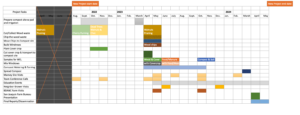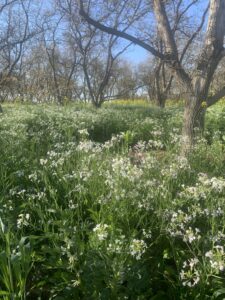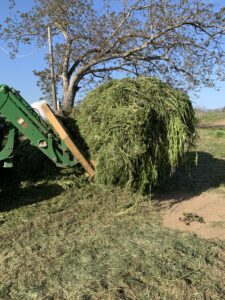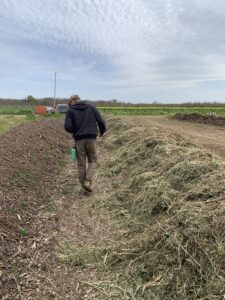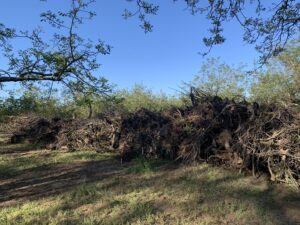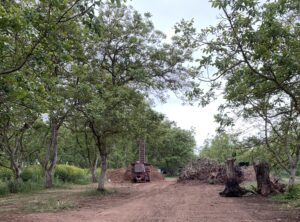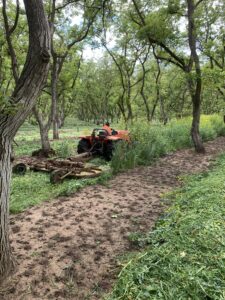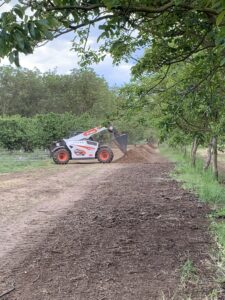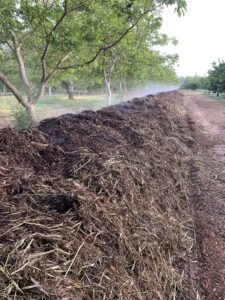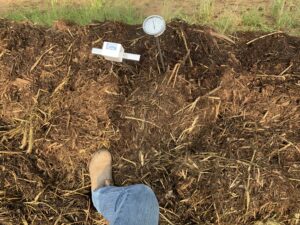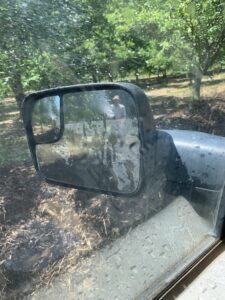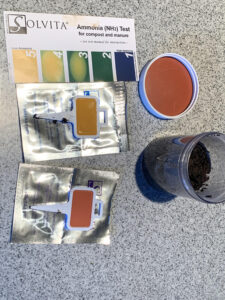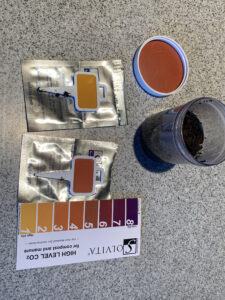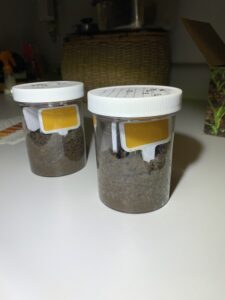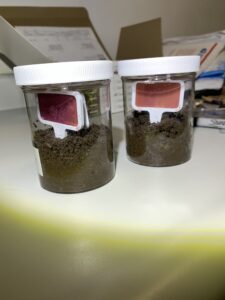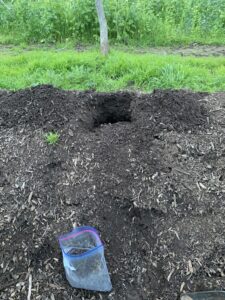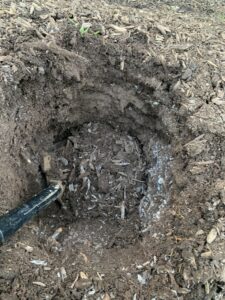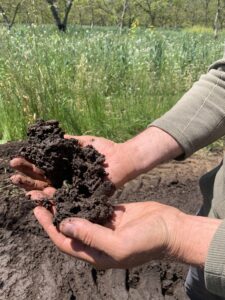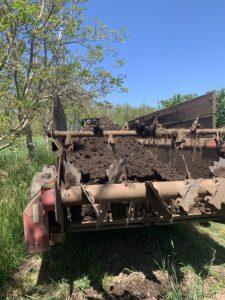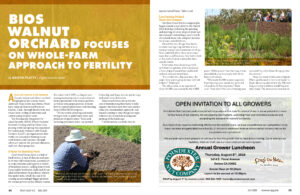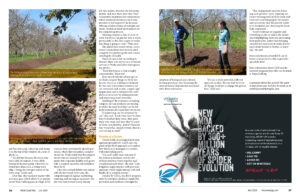Final report for FW22-388
Project Information
Central Valley’s smaller family orchards are facing severe economic and environmental pressures. With new regulations and increasing input costs, these growers are experiencing unprecedented challenges to their survival. The applicant’s farm is transitioning now to the next generation and is sharply aware that practices must change and innovate in order to remain sustainable. By law, agricultural burning is being phased out, and ordinances controlling and monitoring nitrogen application rates are coming into effect. The practices of burning organic waste and excessive nitrogen inputs are recognized as not sustainable and generally harmful to the environment, and to farming.
This project implements an alternative through nutrient-cycling a season’s orchard-waste, cover-crop plant mass and local agricultural waste into compost that then is returned to the orchard. The design also captures carbon from orchard-waste: prunings and dead trees; better preserves nutrients from cover-crops; and proposes local food processor culls and manures. Compost will be built with the advice of consultants and scientists familiar with biodynamic compost methods. The aim is to minimize off-farm inputs, which create a fragile economic and biologic system, and to enlarge the intrinsic nutrient and carbon base within a stable farm system. This project will be shared through site-visits with San Joaquin County growers, biodynamic growers of Northern California, and identified stakeholders. Efforts will be measured through team observations, data collected, and feedback from stakeholders.
RESEARCH
- (a) Develop a pilot compost program, for 40 acres (20 walnut / 20 cherry), on-farm that can incorporate the acres’ woody mass orchard-waste back into a nutrient-cycled soil amendment. This compost offers an alternative to open burning and an opportunity to offset carbon inputs and nitrogen fertilizer applications, the latter which are becoming more costly and threatening to ground water quality. A largely self-sustaining, closed-cycle nutrient cycle has been demonstrated for organic-biodynamic farming (Kaffka & Koepf), and conversion to biodynamic methods emphasizing compost use over imported fertilizers has been shown to significantly reduce tile-drainage nitrate collected across farms (Goldstein, Scully, Kohl and Shearer).
- (b) Capture carbon from orchard wood waste. In composting this waste we aim to capture at least 50% more carbon than the 0% carbon captured now in open burning practices.
- (c ) Seek the reduction of non-organic fertilizer inputs currently contributing to surface and groundwater nitrogen contamination through cycling nutrients with biodynamic methods.
- (d) Better utilize nutrients available in orchard-waste, cover-crop and other agricultural waste materials through composting them.
- (e) Evaluate the feasibility of the project as a cost effective and beneficial solution to identified needs within the resources accessible to the Eilers and for comparable farms in San Joaquin County.
EDUCATION
- (a) Evaluate project replicability for comparable Walnut and Cherry orchards in Central Valley California.
- (b) Open a research conversation about the possible application and benefits of biodynamic methods in Walnut and Cherry orchards in Central Valley CA. Sharing this project with the growers in Northern California offers new frontiers for the application of closed-cycle biodynamic methods in large scale agriculture. Wine growers have had great success with it in recent years, both for benefits to sustainability, product quality and value. However, these methods used on vineyards could be translatable and have not been seen in nut and stone fruit growers yet in the Central Valley.
Cooperators
- - Technical Advisor
- - Technical Advisor
- - Producer
- - Producer (Educator)
Research
August/September 2022: *was our amended start date*
- Consulted with Blair and Brinton by phone and email.
- Pruned & cleaned dead wood out of cherry acreage. Moved this wood material out of the orchard with an orbital brush rake and/or pushed it out with a front load rake on a tractor. Wood material waited in a windrow on the edge of orchard for a time when chipping was possible.
- Prepared the compost site, which was determined to be better placed along the edge of the orchard close to where the wood material was waiting to be processed, rather than the initial idea to transport to a larger area designated for compost making. For this orchard side site little prep was needed to the ground. It was decided better to make the site for this SARE project closer to the field that the waste material is coming out of to minimize transport efforts & costs. The only downside was that we needed to let go of initial plan to use micro sprinklers and opted for a 1000 gallon tank on a trailer pulled behind a truck.
- The originally intended compost site was also established and used for a larger composting effort outside of this project. It was used however for methods of experimentation with building windrows with chips and cover crop before making the compost for this investigation.
- August through winter research was done into what method, how and when would be best to chip the material. The orchards for this project are mature, so there are always a number of full trees that come out. The stumps are best chipped in a tub grinder, which is not a rent-able piece of equipment. There was also a concern for the effort it would take to chip by other means. In addition, the quality of chip was being considered. A smaller-finer chip is preferred for composting. The search finally came to find a service that has a 8 ft tub grinder (smaller than most orchard removal tub grinders with a finer chip option) to come into the field and chip on site. This was scheduled for the first week of May, 2023.
- Contiguously Principle Investigator(PI) applied and received a tractor recycling incentive from the NRCS which facilitated the purchase of a better bucket and machine for dealing with the compost making process. Additionally PI applied to the Healthy Soils incentive program to make compost more traditionally for other parcels. This helped offset the investment for the purchase of a compost turner needed for both projects to turn the planned windrows. This equipment was acquired and was used for this project.
October/November 2022:
- Took out further dead trees in Walnuts & Cherries. Removed from the orchards to wait for chipping. Consulted with Blair and Brinton by phone & email. Planted a soil builder cover-crop with a no-till seed drill. Windrows sat waiting for chipping in the spring.
December 2022-March 2023:
- Cover crop was growing!
April 2023:
- A method was developed for harvesting the cover crop by first experimenting on other acreage and the larger compost project site. The method settled on was 1) mow cover crop down with a rotary mower (this cuts it like hay), 2) rake it up into a row driving an orbital orchard rake on both sides of the cut material, 3) push it out with a brush rake into piles at the end of each tree row, 4) scoop it with a rake to layer into a wood chip windrow.
- The small tub grinder came and chipped up all the material. The result was a nice fine chip. Chip was in a mountain at the edge of the field. A day after grinding was completed the material was moved one bucket load at a time to the windrow site. One bucket full was carefully placed one after other to a length of about 668 feet.
- Simultaneously, in the same day, the cover crop was harvested. (The cover crop in the cherries did not take well. It was seeded a week or so later and may have been affected by the heavy rains of 2022. The cover crop in the walnuts did very well, and grew a good 7+ feet tall. This 20 acres was plenty of green material to match the wood chips. No second pile was built for wood chip and local produce culls as written in original proposal.) A layer of cover crop was placed on top of the wood chips at about a 1:1 ratio. Blair advised when looking at the cover crop to do a 1:1 wood to greens ratio rather than a usual 2:1 ratio. Cover crop was a bit more mature than desired and starting to form seeds. For this reason there was a fear nitrogen was starting to leave the greens.
- The windrow was watered with a pressurized 1000 gallon bubble tank by walking along with a large hose. Initially about 3000gal.
- Blair came for 1st site visit on the day the chips were finished and the cover crop was cut.
- After being watered the wood chips and cover crop were immediately turned with the compost turner attached to a tractor on creeper gear.
- Plant samples of the cover-crop were placed in the freezer and sent 6/5/23 with other samples to Woods End Laboratory (WEL) for nutrient content testing (total-N, C, P, K, Ca, Mg).
- The windrow was measured at 668 ft long by 8’ high and 3’ wide with a parabolic volume of 396 yards.
- This first couple of weeks is crucial for maintaining temperature and moisture. PI and advisers were in daily communication by phone and a Google Spreadsheet. Daily morning temperatures and moisture readings are taken of the pile using a prob temperature meter and a probe moisture sensor made for this purpose. Perfecting and managing water applications with the water tank was developed.
- A gallon of fermented compost starter made by Blair, which contained the biodynamic herbal compost preparations, was added to one 1000-gal tank of water and spread along the pile as a homeopathic support to the process. Ideally in the future PI would make this ferment themselves from on-site grown materials. This supports the start of the pile but could have been omitted. As this project engaged technical advice from a Biodynamic compost adviser it was important and appropriate to add this material. Brinton supported its inclusion since due to the small amount used, it would not quantitatively alter the lab testing of nutrient cycling and carbon capture. This application was repeated a month later in June.
- Note that no local produce culls or manure were incorporated. There was enough green mass to meet the mix-ratio of wood vs green matter and further material was not needed.
- The piles sat and received watering, turning & management as advised. The ideal was to turn every 7 days for 4 weeks, then once a month for 3-4 months.
June 2023:
- Blair came for visit 2. During visit field samples were collected by PI for both bulk-density and nutrient analysis of the first stages of compost. Composite samples were taken into 5 different 5-gallon buckets at 5 different locations along the pile. Each bucket was weighed and a sample from each bucket was then mailed to WEL.
- The piles sit and receive daily temp and moisture monitoring. Watering, turning & management as advised from the monitoring data and visual observations of the pile.
July 2023-February 2024:
- Turning, watering and management continued.
- Blair came for 3rd visit 9/10, during visit took a Solvita compost maturity test. Results read a 5 for NH3 and 4.5 for CO2. Sample was too dry for the test to be conducted immediately and as per instructions, the sample was moistened. If compost becomes very desiccated it sometimes takes a while for the microbial respiration (CO2) to pick up. This can lead to some possible inaccuracy in results. These findings indicate moderately active respiration (CO2 scale) and no emissions of free ammonia (NH3 scale), a good sign that the C:N ratio is appropriate.
March - April 2024:
- First week of March PI took two Solvita compost maturity tests on site. Both samples read a 5 for NH3 (no free ammonia present) and 5-6 for CO2 (medium active respiration).
- On same day 5 samples taken again for final density and nutrient composition and mailed to Woods End Labs.
- Composition analysis received from WEL indicating that the compost was of good quality and ready to be spread as a soil amendment.
- Blair’s 4th visit in April before spreading.
- Compost was spread in 20 acres of cherries with a manure spreader.
May-June 2024:
- Findings analyzed, final reports produced and shared.
WOODS END LABORATORY Methods and Analysis - Will Brinton
Measuring Nutrient Cycling- Samples are dried with sieve removal of inert matter > 3/8" diameter. The material is pulverized in a Wiley-type mill, muffle-furnace ashed at 550C and the resulting ash residue taken up in boiling HCl, diluted, and run by AA/ICP for total minerals (Ca, Mg, P, K, Na)
Measuring Carbon Content:
Lab dried and finely ground material from sieving above was combusted in a LECO-628 CN analyzer. This instrument employs non-dispersive Infrared (NDIR) Absorption to quantify the carbon combusted. The nitrogen in the combustion train is captured and quantified by thermal Conductivity (TC Cell) Detector.
To answer the question about carbon capture through the entire composting cycle, we measured the input (chipped wood prepared into compost with cover crops at a 1:1 ratio) at the start and end of the project. We did on-site volume measures (length/width/height) of piles to derive a true volume in cubic yards (the best-fit formula for this is a parabolic curve); then we did field tests for bulk density using 5-gallon buckets at 5 different locations. Then, once the samples were received at Woods End Lab, they did official lab bulk-density tests using 1-liter standard containers applying compression to simulate 2-feet depth in a pile. The two sets of measures agreed closely. This process was repeated at the end of the composting.
RESEARCH Objectives Results
- (a) This project successfully developed a pilot compost program as specified in this objective. Design, implementation and product from a nutrient-cycled orchard waste compost derived from the waste of two fields (totaling about 40 acres) was completed. Through monitoring, the compost was found to meet the proper temperature and duration, though not even fully necessary as it did not contain raw manure. The final product was qualified as a high nutrient quality by Woods End Lab and PI spread it back on half of this acreage as a nutrient amendment and soil builder.
The biodynamic ferment was used as an inoculant to enhance decomposition. The study did not quantify the effects, but daily monitoring noted that the sweeter smell was present in the days after, and the decomposition enhanced by observations in hand of smell and consistence. Further study is needed. However, biodynamic advising really came into the project through Blair’s guidance in building and approaching the processes in the pile as a kind of digestion of our orchard waste, optimizing the life naturally available on farm to recycle the nutrients. This can be seen further in her presentations with CAFF on YouTube. In developing this report Blair offered, “Properly made compost increases nutrient cycling by increasing enzymatic activity in the soil, increasing micro, nutrient, availability, and sequestering carbon.” And offers the studies cited below.
Reganold JP (1995) Soil quality and profitability of biodynamic and conventional farming systems: a review. Am J Altern Agric 10(1):36–45
Carpenter-Boggs L, Reganold JP, Kennedy AC (2000) Effects of biodynamic preparations on compost development. Biol Agricul Horticul 17(4):313–328
Raupp J, Oltmanns M, others. (2006) Soil properties, crop yield and quality with farmyard manure with and without biodynamic preparations and with inorganic fertilizers. Long-Term Field Experiments in Organic Farming, 135–155
Ram RA, Pathak RK etal (2016) Organic approaches for sustainable production of horticultural crops: a review. Progress Hortic 48(1):1
Condron LM, Cameron KC, Di HJ, Clough TJ, Forbes EA, McLaren RG, Silva RG (2000) A comparison of soil and environmental quality under organic and conventional farming systems in New Zealand. N Z J Agric Res 43(4):443–466
Following this research objective, the project proved plausibility to incorporate both woody & green mass from orchard wood and cover crop waste back into a nutrient-cycled soil amendment. The success of this nutrient capture over-release is discussed further below.
Did we address the need to offer alternatives to burning orchard wood waste? The pilot demonstrates affirmatively an alternative practice to open-burning orchard material. The pros and cons of this alternative over other options need further research and discussion.
The project did offset nitrogen fertilizer inputs for half the acreage. The compost resulted in a good quality. Long-term analysis of this is not readily available in the scope of this project. It is also noteworthy to consider in any analysis that compost can replace but is not a fertilizer itself. Compost is known to add porosity to the soil, increase water-holding capacity, increase microbial life, and increase the humus content of the soil whereas inorganic fertilizers do not. By increasing the potential health of the soil in these ways, it increases the soil food and increases nutrient cycling further within the soil. Technical advisors Blair and Brinton affirm published studies and empirical on-farm experience which shows that the more self-sustaining and closed-cycle the nutrient process is, the less inputs are needed.
- (b) How much of the original carbon did we capture? Initially, we aimed to capture at least 50%. To measure the actual outcome accurately required creating a "mass balance" structure, and this includes tracking volume change and ultimately dry weight change.
Using the volume loss method (i.e. final volume divided into original volume) converted to weight (by taking account of moisture content) we estimated that we captured between 39% and 44% of the input carbon. To make this estimate more accurate, we used the quantitative carbon analysis from the start compared to the end, corrected for weight loss. This resulted in an estimate that was lower than we expected of 33% capture of total carbon. The loss of pile volume method appeared proportional to the loss of carbon but it did under-estimate actual carbon losses.
As an explanatory remark, the fraction of input carbon not captured as final compost would have been biodegraded naturally during the composting process. Mass burning would have lost all the carbon. However, composting is a "slow-burn" process (the compost heated itself to between 140 F and 150 F during the process). This heating speeds up the biological process of decay with the result that a considerable amount of carbon is lost in the atmosphere. This is to be considered biogenic CO2 - i.e. it does not contribute to global CO2 since it is part of nature's cycle). The process also stabilizes a significant part of carbon as compost-humus. This humus will slowly continue to break down once applied to soil but it never completely disappears (as it does if the material is burned). The capture forces in the soil are strong enough to stabilize this carbon for long periods.
There is also a "margin of error" for our estimate of carbon capture. We estimated from the replicated carbon tests (5x) at the start and end of composting that the data variability was between 19 - 22%. For a field study, we believe this level of variance is not unusual but should be used to interpret the results with moderation.
- It was determined that we started with 396 cubic yards of compost and ended up with 179 cubic yards. The loss here is twofold: the increase in density reduces the apparent volume and the loss of organic matter by microbial decomposition reduces the mass. In the original 396 yards, we had 92.2 tons of total dry mass from the trees and cover crops, and after composting we recovered 75.5 tons. When we multiply this out by the respective start (32.2% ) and finish (13.1%) dry organic carbon content, the "mass balance" or recovery of carbon is as follows: start amount = 29.5 tons carbon; end amount = 9.9 tons carbon. Thus, if all the compost was spread over 20 acres, that is approximately 0.5 tons or 1,000 lbs per acre of carbon added. Applying the variability estimate of 20% cited above, the amount of capture from composting chipped tree woods in combination with cover crops on this farm yields a range of soil-added carbon of 800 to 1200 lbs/acre. This small quantity represents a potentially significant and measurable gain of carbon in the soil.
We are satisfied with the result and consider that this was the first time PI was learning and making compost of this kind and in this way. It is possible that differing modes of management including the addition of water and frequency of turning could have influenced this capture upwards or downwards.
- (c ) Did we demonstrate the plausibility of reducing non-organic fertilizer inputs through nutrient cycling into compost? All the nutrients contained in the source ingredients except for potassium appeared to have been recaptured. Potassium declined most likely due to the moisture in the piles so it may only have been displaced downwards into the soil below the piles. Perhaps this potassium should still be considered part of the farm nutrient cycle, especially since all compost areas on a farm should normally be replanted to crops that will access any nutrients leached into the soil during composting.
We also attempted to estimate nutrient recovery. At first we analyzed the chips and cover crop for minerals important for growing - P, K, Ca,Mg. This confirmed for example that the cover crops were very rich in these elements: P (0.7%); K (1.9%); Ca (3.1%) and Mg (0.2%). However, we cannot construct a mass balance since we do not know the dry weight proportion of cover crop mixed into the compost (same for the chipped wood). So we analyzed the fresh mix compost for these minerals and from this (using the model above) we were able to show that we started with the following total pounds of minerals in the compost:
factor Phosphorus Potassium Calcium Magnesium START; pounds present in compost 184 1472 4232 331
At the end, we repeated the analysis and then factored in the weight loss to arrive at the final collected pounds of minerals:
factor Phosphorus Potassium Calcium Magnesium END; pounds recovered in compost 456 608 1500 304
This data suggests we increased phosphorus and we lost potassium and calcium and stayed the same on magnesium. Since this is based on only one full set of tests on well-mixed initial material versus end material, more work (with replicated testing) would be required to obtain a better estimate (and to determine the margin of error for work like this). For example, an increase in P suggests there may have been a transfer from larger inert particles into finer particles. To form lab tests, course, large fragments (> 3/8") are excluded from samples. Potassium is considered very leachable in composts especially if piles are kept wet, and some of this (and calcium) may be found in the soil under the piles. For example, early work on compost mass balance in Massachusetts by Brinton and Schonbeck found that many minerals in green waste compost leached into the soil over 8 months to a depth of over 2 feet. Studies in Germany with composting on biological farms have also shown considerable enrichment of soil by minerals under open-field composts. In this project, we did not include enough analytical effort to sufficiently answer these questions with robust quantitation - it was felt that the appropriate level of lab effort to fully quantify these factors went beyond the scope of a practical field study of this nature.
As a final observation, the amount of minerals in these composts is returned to the soil. It has not been the practice of burning wood to gather ashes and return them to soils, although theoretically, this would have been possible; therefore this is a net recovery of the wood fraction of minerals captured in composting. Another observation is that accepted lab SOP's for compost analysis have the exclusion of "overs" (material not passing a 6 - 10mm sieve) as part of the analysis process. We recommend that a future study require the entire mass of compost and fragments minus foreign material to be repeatedly ground until fine enough to be included in the analysis. This would strengthen the data quality from analysis. - (d) Did we improve nutrient utilization from orchard waste, cover crops, and other agricultural waste materials through composting? While a comprehensive analysis to determine if this method is "better" than others is challenging without comparative data, our findings indicate that the quality of the compost produced enhances soil health by maximizing the benefits of nutrients. We appear to have gained phosphorus but as noted above, this would have to be investigated more. Our results suggest that composting could be more effective than burning wood and spreading the ash. We would have to conduct a direct study on this comparison to draw any further conclusions.
It is also possible that incorporating green mass or cover crops into compost likely retains more nutrients compared to leaving them on the orchard floor to dry or tilling them into the soil. However, if leaching from compost has occurred this would not be the case. If the leaching happens in aisles between the trees, then the minerals could be recaptured by green manures. An advantage of composting is that it concentrates and conserves nutrients, creating a clear and concentrated nutrient retention process.
- (e) Was this a cost-effective and beneficial solution? We learned a lot about the feasibility of a farmer designing, implementing, and gaining from a whole nutrient cycling compost program. It was well within plausibility and reasonability. However, the comparison suggestions below in recommendations would be very important to address if it is a recommendable best practice in terms of cost-effectiveness and beneficial solution. It is possible to calculate the entire costs of composting by accumulating various factors: machine time and fuel utilized; hours of labor by differing persons; and any supplemental materials used. In 2008 Brinton published a paper in Biocycle on how to calculate the "Energy Index" of composting which includes all machine time fossil fuel costs compared to the end value of the carbon. In it, it was proposed that climate-smart composting would include the energy balance. A study of this quantitative nature has not been performed in the scope of this project.
Research outcomes
Recommendation to Farmers looking for beneficial solutions:
As PI it is invaluable and rewarding to tangibly take on research that may contribute to beneficial solutions to real problems. The motivation should be inherent, but the time and permission to work on it is difficult without the support of a grant like this one. It became clear to us that it is hugely helpful to have the opportunity to scratch our heads enough times and come up with better ideas. The search and decision to use a small tub grinder for example may not have happened otherwise.
Very few farmers in our region know how to make compost, yet nutrition is a top priority for farmers and recognized currently by sustainability grants and incentive programs. It would behove agriculturalists to offer more examples and experiences of how to do compost on farm. Our recommendation is to put nutrition back into farmers hands, enable them to learn to make compost, up cycle what they have locally, then decide how one may or may not use it. We have not really “solved” it, but we hope that this stimulated question, conversations, further inquiry and experimentation for agricultural stockholders. Making compost is labor intensive the first month, takes space and time, but it is also a dynamic fun work. Similar to cooking there is a satisfaction on getting the pile to develop nicely and transform into a nutrient rich soil amendment.
Recommendation for further research:
A comparison study of practices terminating the waste materials on the orchard floor surface or incorporated into the soil through tillage would further illuminate how much better composting it might be. A study would need to look at a comparison of nutrient and carbon capture, greenhouse gas emissions from machine work involved, labor cost and time, all rental and material costs, and convenience should be considered. Additionally, there are variations in termination practices of wood prunings and cover crops within this comparison. A comparison could also be made to the costs and viability of taking waste off the farm by burning, landfill, or selling to a cogeneration facility.
Discussion on possible improvement of project execution:
Being the first time PI was making compost of this kind and scale there was a learning curve in finding the best and available ways to do the project even with technical guidance from Blair and Brinton. Because of this, some areas could be better for another go at it. Ideally, we would have cut the cover crop a few weeks earlier and done a different ratio of wood chip to cover crop, but we were waiting for the tub grinder. Blair retrospectively recommends the use of a more conservative turning schedule. Turn after the first seven days if the temperature is up to 135 then turn only when the temperature is dropping. We could have maintained moisture content more evenly and universally throughout the pile having learned better watering practices. It was not possible for our location, but a drip method of micro-sprinkler could be recommended over the pump-powered tank used. After working with a lab like Woods End initially, their analysis could help formulate a better recipe that takes more accurately the moisture content of starting ingredients, carbon density, nitrogen ratio, and porosity.
Education and Outreach
Participation summary:
Education and Outreach Methods:
- Conference Presentation: PI sought a conference to present the project at and was introduced to the Small Farmers Conference 2024, hosted by Community Alliance of Family Farmers (CAFF). PI applied and was accepted to give a presentation at 2024 Small Farmers Conference. Presentation kicked off the week long programming of sessions on February 25, 2024. PI built a slide presentation with images and video to share the process from the PI’s perspective. Blair also presented a separate slide presentation from the adviser’s standpoint and expertise. This was a recorded live 1hr presentation online now available on Youtube https://youtu.be/lvfnJ3Uxymo?si=y7KIu7PzmWWraNxz
- To meet the proposal for on site Field Day events, in the spring of 2023 PI started to talk with CAFF about the project and the possibility of them hosting a field day on-site to share the project with local growers, researchers and agricultural stakeholders. This conversation went on until a field day was realized on April 10, 2024 as we neared the completion of the project. We collaborated and took efforts to make sure there was a porta-potty, shade, chairs, and parking available for gathering. CAFF organized RSVPS, held a welcome table, and provided snacks and further resources. About 35 people attended.
- The second field day manifested April 6, 2024, with the Biodynamic Association of Northern California (BDANC). This idea began as the original proposal for this project was written and this organization wrote a letter of support. However, it was followed up with by Wade attending the organizations winter meeting in January 2024 and proposing a Spring Field Day. This was met positively and subsequently PI met by Zoom meetings to plan with the organization. Porto-potty, shade, chairs for gathering, parking were organized. BDANC supported with registration and welcome table and provided snacks and further resources. About 35 different people attended.
- Subsequently these events lead to further outreach.
- CAFF wrote a featured blog post, available as an ongoing resource at https://caff.org/whole-orchard-nutrient-management-on-farm-composting-at-heartwood-farms/ This included some work and communication on PIs part to proof and approve before posting publicly.
- CAFF had been approached by a reporter for West Coast Nut Magazine after publishing the flyer for the April field day. PI was asked permission if they could come and document. This was agreed on and the reporter came with a camera to document. A video was published online through West Coast Nut magazine by Kristin Platts and a print article was published in the July 2024 West Coast Nut Magazine. These publication also had some back and forth for proofing.
- A featured article was printed in the BDANC's quarterly newsletter, mailed out to all members.
Activities Results Time Line
- Wade, Eilers and Blair gave a presentation at Community Alliance of Family Farmers (CAFF) 2024 Small Farmers Conference online on February 25, 2024. At least 40 people attended live.
- Presentation now available CAFF’s website and Youtube Channel https://youtu.be/lvfnJ3Uxymo?si=y7KIu7PzmWWraNxz This is now a widely shareable and accessible free resource.
- April 6, 2024- PI (Eilers and Wade) host a Field Day onsite with the Biodynamic Association of Northern California (BDANC). About 35 people attended: including growers, biodynamic consultants, and garden teachers. Good conversation generated after presentation and compost was still available in the windrow for hands on observation.
- April 10, 2024 - PI hosted a Field Day onsite presenting with Blair with CAFF. Also about 35 people in attendance, including at least representatives from 4 local growers of the same crops, and mostly researchers and agricultural stakeholders from different organizations/agencies in the region. Good conversation generated after presentation and compost was still available in the windrow for hands on observation. Kristin Platts for West Coast Nut approached CAFF about featuring the event and was welcomed to film and report the field day.
- May-June 2024 - The project and Field Day was featured in a blog post by CAFF, available as an ongoing resource at https://caff.org/whole-orchard-nutrient-management-on-farm-composting-at-heartwood-farms/
- May-June 2024 video published in West Coast Nut magazine by Kristin Platts
- June 2024- a featured article in the BDANC's quarterly newsletter, mailed out to all members.
- July 2024 article published in West Coast Nut magazine by Kristin Platts, available in print and online. This magazine is widely mailed to all nut growers on the West Coast.
Education and Outreach Outcomes
We are pleased how the education and outreach activities realized. Though we did not do exactly what was written in the proposal, the methods and results successfully reached audiences hyper locally, regionally, industry wide, and beyond arguably better than what was proposed.
Objectives:
(a)
Outreach activities successfully (1) shared and exceeded the goal to reach 3-5 growers from San Joaquin County of a similar size and crop make-up. These growers also met the aim to reach a mix of generation. (2) We did not manage yet to share as proposed with the San Joaquin Farm Bureau, however we did share locally through the CAFF Field Day and online and printed subsequent materials available. (3) We have not sent a report to the Air Pollution Control District but may still send them a this final report.
Methods: (1) We initially imagined that site visits through out the process would be important, we quickly realized that it was more appropriate as a sharing towards the end of the project. Towards the end we were more confident about the methods and process and actually had something to share. (2) Our relations with CAFF really took the place of the original intention to work with Farm Burea. This is simply because we realized CAFF is actively holding Field Days and was prepared and available to organize. (3) Again this point has not been pursued.
(b)
Outreach activities: (5) BDANC was successfully invited for a Field Day and (6) it was successfully reported in the member’s newsletter. (7) An article for Stella Natura has not yet been submitted, it may still. (8) Reports shared by Woods End Lab have not yet been published.
Plausibility
Benefit
Cost
